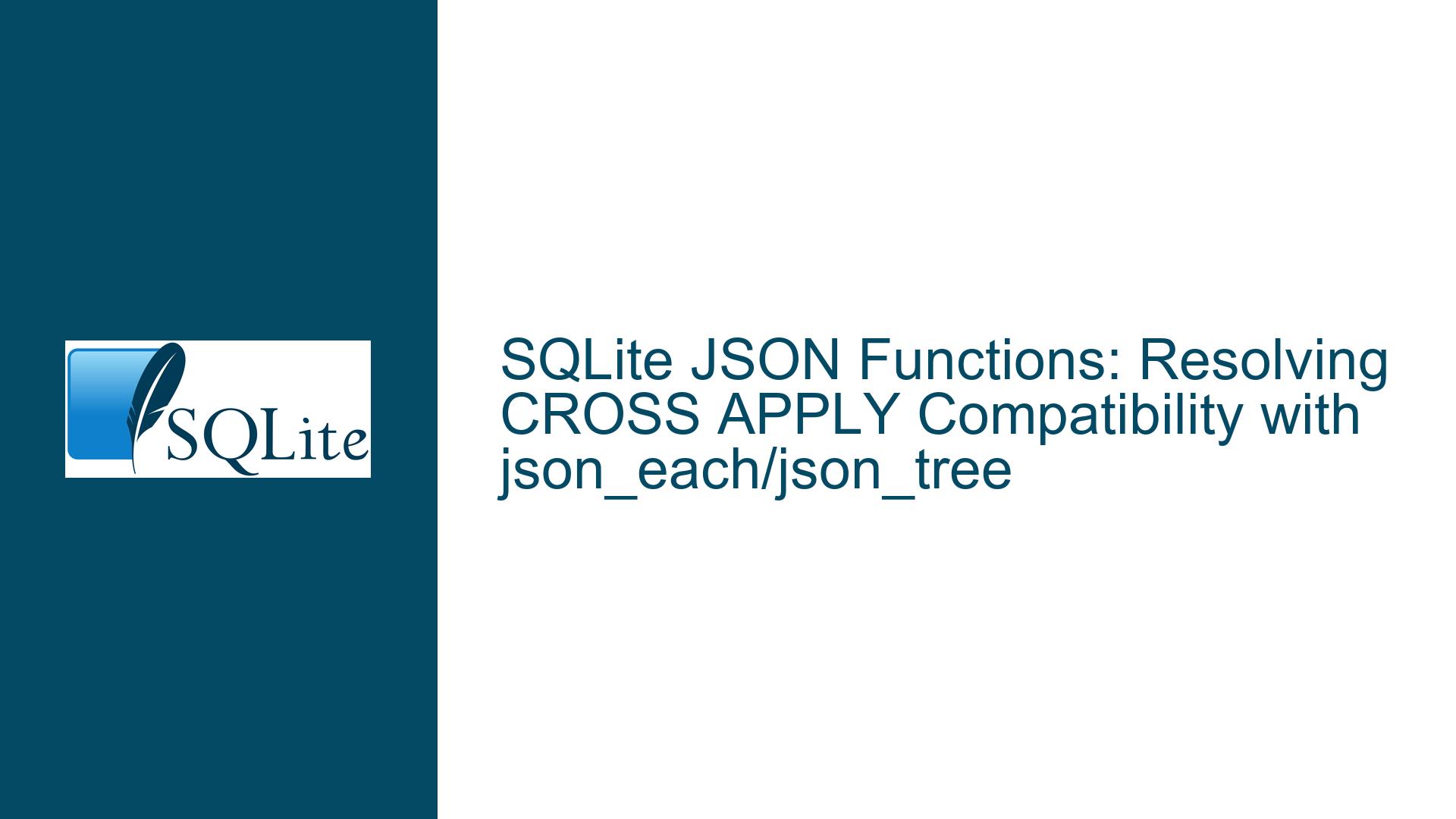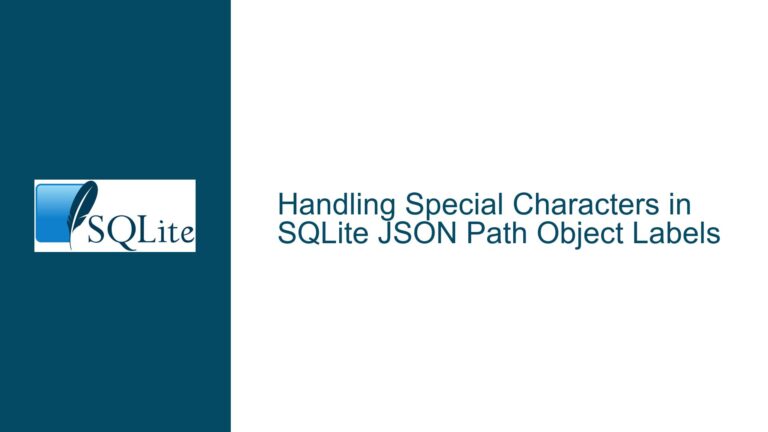SQLite JSON Functions: Resolving CROSS APPLY Compatibility with json_each/json_tree
JSON Table-Valued Functions and Lateral Join Syntax Conflicts in SQLite
Issue Overview: Misalignment Between JSON Expansion Syntax and Lateral Join Expectations
The core issue revolves around SQLite’s JSON1 module functions json_each and json_tree and their interaction with join syntax. These functions are designed to expand JSON objects or arrays into relational rows, enabling SQL-based operations on semi-structured data. However, the current implementation requires the use of INNER JOIN or LEFT JOIN clauses to bind the JSON functions to the parent query. This creates a semantic and technical mismatch because these functions inherently depend on values from the outer query, a dependency pattern that aligns more closely with lateral joins (implemented in other databases as CROSS APPLY or LATERAL JOIN).
When a JSON function like json_each references a column from an outer table (e.g., table1.json_column), it creates a correlated subquery relationship. In SQL standards, lateral joins explicitly handle this by allowing the inner query to reference columns from the outer query. SQLite, however, does not natively support the CROSS APPLY or LATERAL keyword. Instead, it relies on traditional join syntax, which implicitly permits column references from outer tables in the json_each/json_tree context. This leads to ambiguity in query interpretation, especially when interfacing with ORM tools like .NET’s Linq2DB that generate CROSS APPLY syntax expecting SQLite to recognize it.
The mismatch manifests in two ways:
- Semantic Incorrectness: Using
INNER JOINorLEFT JOINimplies a relationship based on predicate conditions (e.g.,ON table1.id = table2.id), whereasjson_each/json_treederive their input directly from a column in the outer query. There is no "join condition" in the traditional sense—the JSON function is applied to the outer column. - Tooling Incompatibility: ORM frameworks that translate LINQ-style queries into SQL often generate
CROSS APPLYfor operations requiring lateral joins. SQLite’s lack of support for this syntax forces developers to either modify the ORM’s SQL generation logic or abandon SQLite-specific optimizations.
This issue is exacerbated when migrating codebases from databases like Microsoft SQL Server or PostgreSQL, where CROSS APPLY or LATERAL is standard for JSON expansion. Developers accustomed to these patterns may inadvertently write non-portable queries or face hurdles when adapting existing logic to SQLite.
Possible Causes: SQLite’s Join Syntax Limitations and Historical Design Decisions
Absence of LATERAL Keyword Support:
SQLite’s parser does not recognizeCROSS APPLY,OUTER APPLY, orLATERALas valid join operators. This is a deliberate design choice rooted in SQLite’s minimalistic approach to SQL standard compliance. While other databases have adopted lateral joins to handle correlated table-valued functions, SQLite relies on implicit correlations within joins. For example,json_eachcan reference outer columns without explicit syntax because SQLite’s engine resolves these references at runtime. However, this creates ambiguity in query intent and limits interoperability.JSON1 Module’s Dependency on Outer References:
Thejson_eachandjson_treefunctions are intrinsically tied to the outer query’s context. When invoked, they require a JSON string input, which is typically sourced from a column in the outer table. For example:SELECT table1.id, je.value FROM table1 INNER JOIN json_each(table1.json_column) AS je;Here,
json_eachdepends ontable1.json_column, making the join effectively a lateral operation. SQLite allows this because it treats the JSON function as a correlated subquery, but the syntax does not reflect the lateral nature of the dependency.ORM and Query Translation Challenges:
ORM libraries like Linq2DB abstract SQL generation, translating LINQ operations into database-specific syntax. When a LINQ query involves iterating over JSON array elements, the ORM may generateCROSS APPLYto represent the lateral relationship. Since SQLite rejects this syntax, developers must either:- Modify the ORM’s SQL generator to emit
INNER JOINinstead ofCROSS APPLY. - Use raw SQL fragments, bypassing the ORM’s abstraction.
Both solutions undermine the productivity benefits of using an ORM and introduce maintenance overhead.
- Modify the ORM’s SQL generator to emit
Backward Compatibility Constraints:
SQLite prioritizes backward compatibility, making it reluctant to introduce syntax that could break existing queries. AddingCROSS APPLYsupport would require changes to the parser, optimizer, and query planner—components that are highly stable but resistant to modification. Even if the SQLite team were to implement lateral joins, they would need to do so in a way that does not conflict with legacy behavior.
Resolving the Conflict: Workarounds, Query Rewrites, and Future Considerations
Workaround 1: Emulating LATERAL Joins with Subqueries or CTEs
To approximate lateral join behavior without CROSS APPLY, use subqueries or Common Table Expressions (CTEs) to isolate the JSON expansion logic:
-- Using a subquery
SELECT t1.id, je.value
FROM table1 AS t1
JOIN (
SELECT json_extract(t1.json_column, '$') AS json_data
FROM table1
) AS sub
JOIN json_each(sub.json_data) AS je;
-- Using a CTE
WITH expanded_json AS (
SELECT id, json_each.value
FROM table1, json_each(table1.json_column)
)
SELECT id, value FROM expanded_json;
This approach decouples the JSON function from the outer query’s join syntax, but it adds unnecessary complexity and may impact performance due to intermediate result sets.
Workaround 2: ORM-Specific Adaptations
For Linq2DB users, customize the SQL generation logic to replace CROSS APPLY with INNER JOIN. This can be achieved via Linq2DB’s query interception hooks:
// Example Linq2DB customization
public class CustomSqlGenerator : SQLiteSqlBuilder
{
protected override void BuildCROSSAPPLY(SqlCROSSAPPLY crossApply)
{
// Replace CROSS APPLY with INNER JOIN
StringBuilder.Append("INNER JOIN ");
BuildExpression(crossApply.Table);
}
}
While effective, this requires deep integration with the ORM and may not handle all edge cases.
Workaround 3: Feature Request and Community Advocacy
Petition the SQLite team to add CROSS APPLY/LATERAL syntax as an optional extension. This would involve:
- Drafting a detailed proposal to the SQLite mailing list.
- Demonstrating real-world use cases (e.g., ORM compatibility, query clarity).
- Providing a patch or proof-of-concept implementation.
Long-Term Solution: Leveraging SQLite’s Extensibility
Develop a custom SQLite extension that implements CROSS APPLY support using the Virtual Table or Loadable Extension APIs. This would allow developers to enable lateral joins without waiting for official support. However, maintaining such an extension requires significant expertise and may not be feasible for all teams.
By understanding the interplay between SQLite’s design philosophy, JSON function behavior, and ORM constraints, developers can navigate the current limitations while advocating for future improvements. The workarounds outlined here provide immediate relief, but the ultimate resolution depends on broader syntax support in SQLite itself.






